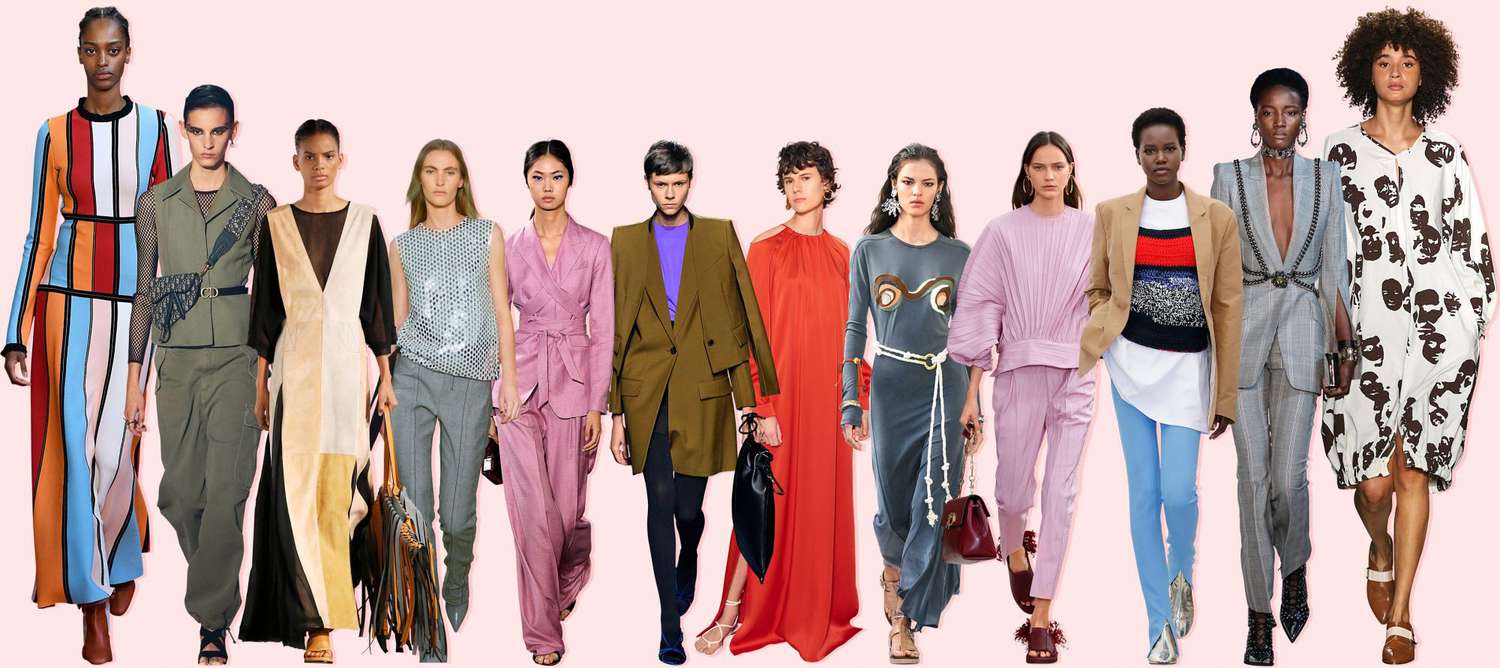How Sustainable Fabric Trends Are Shaping Branded Clothing Collections
How Sustainable Fabric Trends Are Shaping Branded Clothing Collections
Blog Article
Recognizing Clothes: The Value of Material Options in Your Closet
The selection of fabric in clothing plays a crucial duty in both looks and capability. Various products offer differing levels of breathability, toughness, and comfort, straight affecting the wearer's experience. Comprehending these nuances can enhance one's wardrobe markedly. Yet, many neglect how these choices can affect not just individual style, however also sustainability. What textile decisions could redefine your wardrobe and align it with both design and duty?
The Function of Material in Fashion and Performance

Common Fabric Kinds and Their Qualities
When choosing clothing, comprehending the attributes of typical fabric types is important for making informed options. Cotton, a widely-used all-natural fiber, is understood for its breathability, soft qualities, and flexibility, making it ideal for sportswear and daily garments. Bed linen, an additional natural option, flaunts superb moisture-wicking buildings and a distinct structure, perfect for cozy climates.Wool, usually favored for its heat and durability, differs in excellence; merino wool is soft versus the skin, while coarser kinds are used for outerwear. Synthetic fabrics like polyester and nylon supply longevity and resistance to creases, making them prominent for activewear and travel garments. Blends, which incorporate synthetic and natural fibers, can improve performance while keeping comfort. By recognizing these fabric characteristics, people can select clothing that straightens with their way of living and aesthetic choices.
Breathability and Comfort: Picking the Right Fabrics for Various Environments
Selecting the ideal materials for different climates can significantly enhance comfort and general wearability. Breathable products are vital in hot climates, as they enable air circulation and wetness dissipation. Fabrics such as cotton, bed linen, and moisture-wicking synthetics successfully attract sweat away from the body, maintaining the wearer cool and dry. On the other hand, in cooler climates, thicker textiles like wool or fleece offer insulation while preserving breathability, making sure heat without overheating.Additionally, the selection of fabric weight plays an essential function; lightweight textiles are better for summer, whereas heavier options are suited for winter wear. Comprehending the distinct properties of each fabric allows people to clothe appropriately for differing weather condition problems. Eventually, selecting breathable and comfy textiles customized to specific climates can considerably enhance day-to-day convenience and boost the total experience of wearing apparel.
Resilience and Treatment: Exactly How Material Influences Longevity of Your Closet
Choosing the right products can significantly influence the sturdiness and treatment requirements of a closet. Fabrics such as cotton and polyester are known for their resilience and convenience of upkeep, making them perfect for everyday wear. In contrast, delicate products like silk and lace require even more mindful handling and specialized cleaning approaches, which can raise the moment and initiative needed for care. Branded Clothing.Durability is likewise affected by the textile's weave and surface; securely woven textiles often tend to resist damage better than loosely woven alternatives. In addition, synthetic blends usually supply improved sturdiness, incorporating the very best top qualities of multiple fibers.Understanding the treatment directions for every textile is necessary, as inappropriate washing or drying out can result in premature wear. Ultimately, choosing long lasting products can lead to a longer-lasting wardrobe, reducing the frequency of replacements and adding to a much more lasting style option
The Influence of Material on Fit and Shape

Lasting Textile Choices: Making Eco-Friendly Decisions
The effect of textile expands beyond fit and shape to incorporate ecological elements, motivating an expanding passion in sustainable textile selections. Eco-friendly fabrics, such as natural cotton, hemp, and Tencel, are gaining traction amongst consumers who prioritize sustainability in their wardrobes. These materials are often produced with fewer chemicals and water, lowering their ecological footprint.Additionally, recycled textiles, made from post-consumer waste, use a cutting-edge option to the textile sector's pollution issue. Brands increasingly welcome transparency in their sourcing approaches, enabling consumers to make educated decisions concerning their purchases.Choosing sustainable fabrics not just supports ethical practices but additionally motivates the apparel industry to take on even more liable production methods. As understanding of environmental concerns climbs, people are prompted to review the long-lasting effect of their fabric selections, promoting a motion in the direction of a much more lasting and environmentally mindful technique to fashion.
Elevating Style: Just How Material Can Transform a Clothing
While many might concentrate on color and cut when choosing a clothing, the choice of fabric plays a vital role in raising design and boosting total look. Different products communicate distinct state of minds and messages; as an example, silk shows luxury and refinement, while jeans uses a laid-back, relaxed ambiance. The structure and drape of a textile can drastically alter Recommended Reading the silhouette, with organized fabrics providing a refined appearance and softer ones producing a much more fluid, loosened up aesthetic.Moreover, the weight of the fabric affects wearability across seasons. Lightweight textiles like linen and cotton are perfect for summer season, while larger materials such as woollen and velvet provide heat and style in chillier months. Understanding textile properties, such as breathability and stretch, also encourages people to make enlightened selections that boost comfort without endangering design. Ultimately, the right fabric can change an attire from ordinary to amazing, making it a crucial factor to consider in any kind of closet.
Regularly Asked Questions
Exactly how Do I Identify the Material Web Content of My Clothes?
To identify material web content, one can analyze treatment tags, conduct melt tests for fiber recognition, or seek advice from material examples. These techniques help distinguish materials, making certain informed options for apparel care and maintenance in day-to-day wear.
Can Material Choice Affect My Mood or Confidence?
Textile selection can greatly influence a person's mood and self-confidence. Branded Clothing. Particular products may stimulate sensations of convenience or beauty, while others can really feel limiting or uncomplimentary, inevitably influencing self-perception and psychological well-being throughout the day
What Fabrics Are Best for Delicate Skin?
For people with sensitive skin, all-natural fabrics like cotton, linen, and bamboo are often advised. These materials are breathable, hypoallergenic, and less likely to cause inflammation, making them suitable selections for comfort and skin health and wellness.
Exactly how Do I Correctly Wash and Care for Various Fabrics?
To effectively wash and care for various materials, one have to take into consideration each material's particular needs, including temperature level setups, detergents, and drying out approaches, making certain durability and preserving the material's original top qualities for perfect usage.
Are There Specific Fabrics for Athletic or Efficiency Use?
Athletic or efficiency wear usually makes use of materials such as nylon, polyester, and spandex. These products are developed for moisture-wicking, breathability, and versatility, improving activity and navigate to this site convenience throughout exercises while offering toughness and assistance. Conversely, in cooler environments, thicker materials like wool or fleece supply insulation while preserving breathability, making certain warmth without overheating.Additionally, the option of material weight plays a vital duty; lightweight materials are better for summer, whereas larger options are matched for winter months wear. In contrast, delicate materials like silk and lace require even more careful handling and specialized cleaning techniques, which can raise the time and initiative needed for care.Durability is likewise influenced by the fabric's weave and finish; securely woven fabrics often tend to stand up to wear and tear better than loosely woven alternatives. In contrast, stiff fabrics can limit activity but supply a traditional, refined look.Moreover, the thickness and structure of the fabric can affect the aesthetic understanding of body form. The influence of fabric prolongs past fit and shape to encompass environmental factors, triggering a growing interest in lasting textile selections. The structure and drape of a fabric can dramatically alter the shape, with organized textiles giving a refined appearance and softer ones producing a much more fluid, loosened up aesthetic.Moreover, the weight of the textile influences wearability across periods.
Report this page